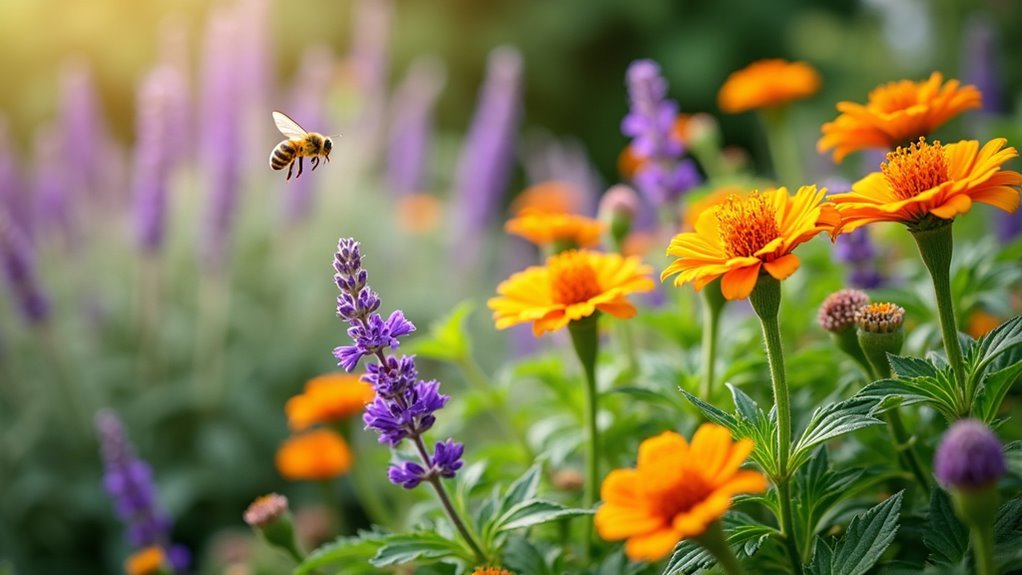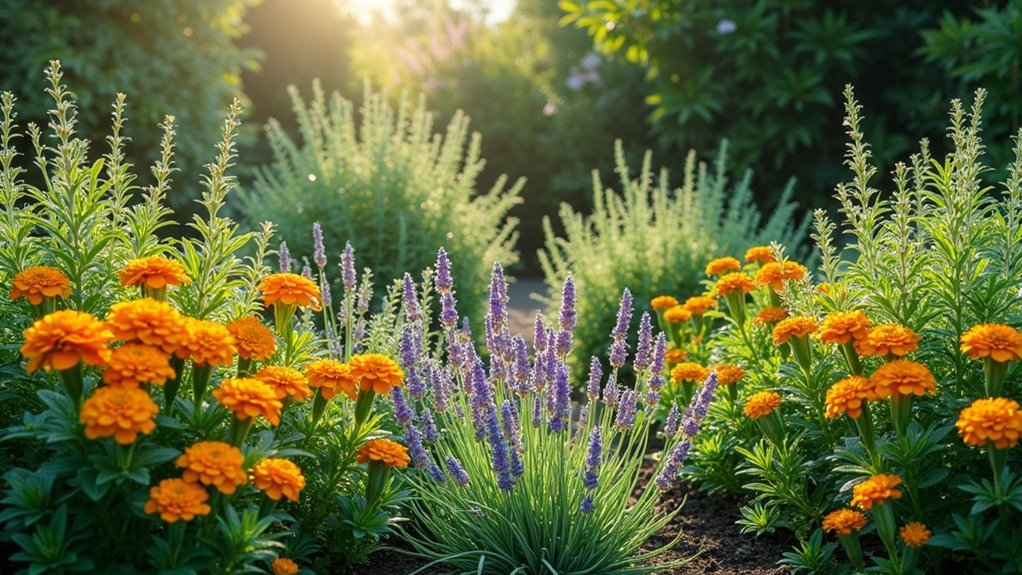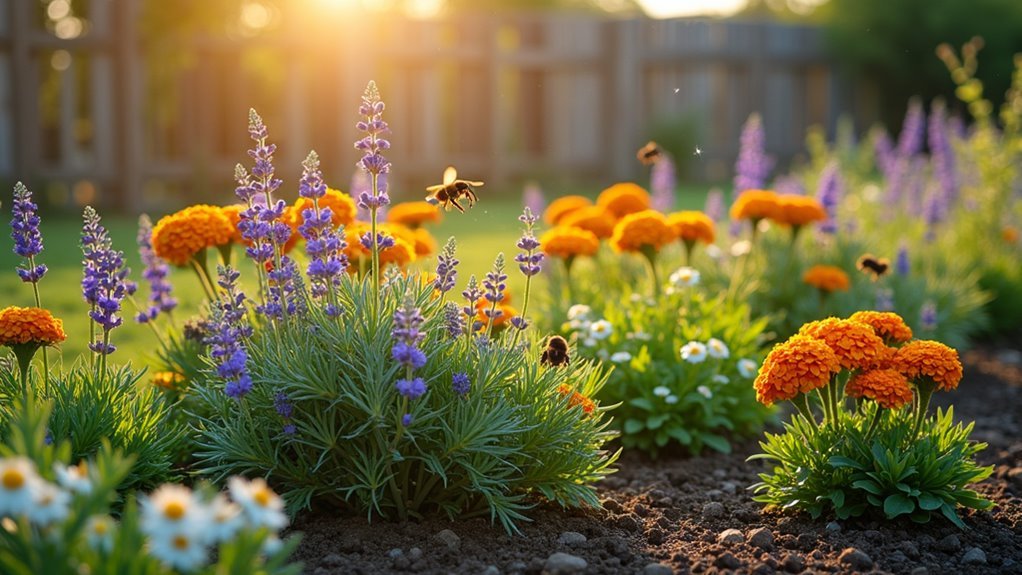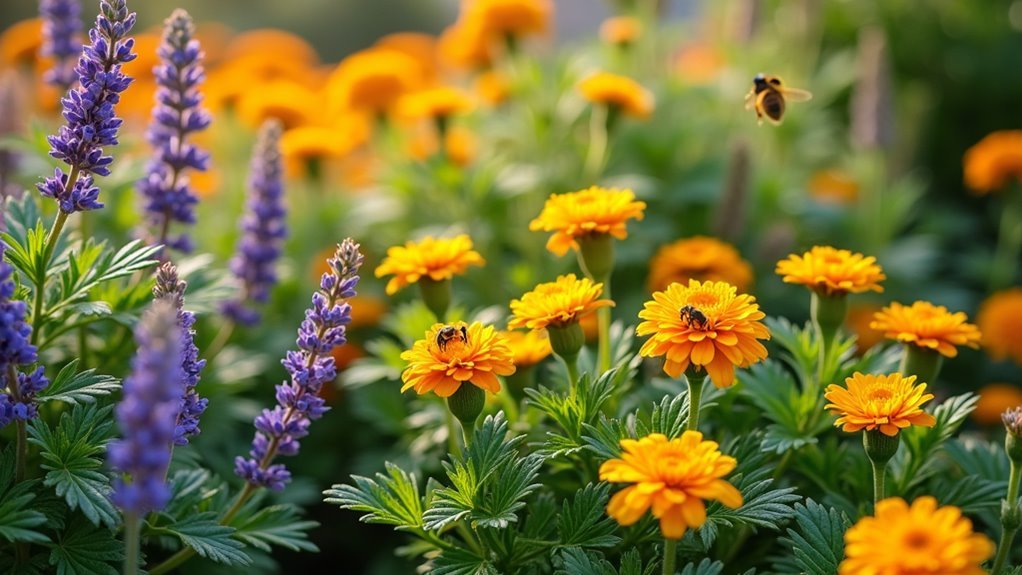You can protect your garden from pests while supporting bee populations by planting aromatic herbs like basil, mint, and lavender that repel unwanted insects without harming pollinators. Marigolds work exceptionally well as dual-purpose plants, deterring pests while attracting beneficial insects. Red geraniums contain minimal pollen, making them less appealing to stinging insects but safe for bees. Position these plants strategically near outdoor living spaces and maintain proper soil health for maximum effectiveness. Discover advanced placement techniques that’ll transform your garden into a pest-resistant pollinator haven.
Natural Pest Deterrents That Support Pollinator Health

While many commercial pest control methods can harm beneficial insects, certain plants offer a natural solution that protects both your garden and local pollinator populations.
Plants that repel wasps and other pests work differently than harsh chemicals, making them less toxic to bees while still maintaining effective pest control.
Natural plant-based pest deterrents offer effective garden protection without the harmful chemical impact on beneficial bee populations.
Aromatic herbs like basil and mint use their strong scent to deter unwanted insects without repelling bees entirely.
Lavender serves as a great addition to any garden, actively attracting beneficial pollinators while keeping wasps away.
Red geraniums make excellent choices since they contain minimal pollen, reducing their appeal to stinging insects.
When selecting flowering plants for pest control, you’re creating a balanced ecosystem that protects pollinators while naturally managing garden pests.
Aromatic Herbs for Chemical-Free Garden Protection
When you’re seeking chemical-free protection for your garden, aromatic herbs offer a powerful and natural solution that repels pests without harming the environment.
These plants effectively repel bees and wasps from specific areas while protecting bees overall by eliminating the need for chemical insecticides.
Basil serves as an excellent dual-purpose herb, thriving in full sun while providing culinary benefits and pest protection. Its strong scent naturally deters stinging insects without causing harm.
Mint’s vigorous growth and sharp aroma make it another effective natural pest deterrent, though you’ll need regular maintenance to control its spread.
Lavender offers versatility with its calming scent that repels wasps while attracting beneficial butterflies.
Citronella’s citrus fragrance rounds out your aromatic arsenal, deterring various pests naturally.
Strategic Plant Placement to Maximize Pest Control Benefits

Selecting the right aromatic herbs represents only half the equation for effective natural pest control.
Strategic placement of repel plants maximizes their effectiveness against wasps while protecting bees. Position aromatic varieties like basil and mint directly near outdoor living spaces where you’ll benefit most from their pest-deterring properties.
Group marigolds and wormwood together to amplify their natural deterrent effects rather than scattering them throughout your garden. Create natural barriers by placing citronella and eucalyptus around patios and entryways where stinging insects typically enter.
Choose red-colored flowers like geraniums in areas where you want fewer insects, as bees find these colors visually unattractive. Guarantee adequate sunlight and proper spacing for all pest control plants, since healthy specimens provide stronger aromatic protection than struggling ones.
Flowering Plants That Attract Beneficial Insects While Repelling Pests
The most effective pest control gardens feature dual-purpose flowering plants that simultaneously repel unwanted insects while welcoming beneficial ones.
You’ll find that marigolds are among the best choices, using their strong scent to repel pests while their vibrant blooms attract beneficial insects like pollinators.
Lavender works similarly, deterring wasps with its fragrance yet drawing butterflies to enhance your garden ecosystem.
Red geraniums effectively keep bees away through minimal pollen production while maintaining visual appeal.
Basil and chives serve double duty as they repel pests and attract beneficial insects when flowering.
Mint and thyme also excel at this balance, using aromatic properties to deter unwanted visitors while encouraging helpful species that support natural pollination and pest control.
Creating Garden Zones for Balanced Pest Management

You can transform your garden into an effective pest management system by creating distinct zones that serve different purposes.
Strategic plant placement allows you to position strong-scented repellent plants like basil and citronella near patios and seating areas while establishing separate beneficial insect sanctuaries filled with bee-friendly flowers.
This zoning approach lets you control pests where you need protection most while maintaining dedicated spaces that support pollinators and other helpful garden allies.
Strategic Plant Placement Zones
Where should you position pest-repelling plants to maximize their effectiveness while maintaining a thriving garden ecosystem? Strategic placement involves creating distinct zones that serve different purposes. You’ll want to plant garlic and other strong-scented herbs in well-drained soil near outdoor seating areas where their repellent effects work best. This preventative measure keeps wasps away while protecting beneficial pollinators.
Consider using red varieties of flowers since bees can’t see red wavelengths, reducing attraction while maintaining pest control. Position your pest-repelling plants in separate sections from bee-friendly flowers, creating a balanced garden layout.
| Zone Type | Recommended Plants | Placement Strategy |
|---|---|---|
| High Traffic Areas | Mint, Rosemary | Near patios, walkways |
| Vegetable Gardens | Garlic, Chives | Companion planting rows |
| Full Sun Zones | Citronella, Eucalyptus | Open, sunny locations |
| Moist Areas | Wormwood, Ferns | Shaded, well-watered spots |
| Separation Zones | Marigolds, Basil | Buffer between garden sections |
Beneficial Insect Sanctuaries
While pest-repelling plants form your garden’s defensive perimeter, beneficial insect sanctuaries create the ecological balance that makes natural pest management truly effective.
You’ll want to designate specific zones with native flowering plants that support biodiversity while encouraging pollinators and predatory insects to thrive.
Plant lavender and marigolds strategically—they’ll deter wasps and bees while providing habitat for beneficial insects like ladybugs and lacewings.
These natural predators control pest populations without chemical interventions. Group repellent plants such as basil and mint near vulnerable crops to create protective barriers that don’t disrupt beneficial insect activity.
Maintaining diverse plant species in your garden enhances resilience against pest outbreaks, fostering healthy predator-prey relationships that reduce your reliance on conventional pest control methods.
Maintaining Plant Health for Optimal Pest Deterrent Properties
You’ll maximize your pest-repelling plants’ effectiveness by mastering proper watering and soil management techniques.
Keep your soil consistently moist but well-drained, as waterlogged conditions weaken plants like basil and mint, reducing their natural pest-deterrent compounds.
Focus on enriching your soil with organic matter and maintaining ideal moisture levels to guarantee your defensive plants stay healthy and potent against unwanted garden visitors.
Proper Watering Techniques
Since proper watering directly impacts your pest-repelling plants’ effectiveness, you’ll need to master consistent moisture delivery without creating waterlogged conditions that invite root rot. Water plants like basil and mint in the morning, allowing leaves to dry during daylight hours. This prevents fungal diseases while preserving their aromatic properties that keep pests away.
| Plant Type | Watering Frequency |
|---|---|
| Red geraniums | Every 2-3 days |
| Marigolds | Daily during heat |
| Citronella | 3-4 times weekly |
Use well-drained soil for wormwood and eucalyptus to prevent water accumulation. Check soil moisture regularly—most pest-deterrent plants require little water but need consistent hydration. Red geraniums and other pest-repelling varieties achieve best results when properly hydrated, maintaining strong scents that deter unwanted insects while protecting beneficial honey bees.
Soil Health Management
Beyond watering, your soil’s health determines whether your pest-repelling plants can produce the strong compounds that effectively deter unwanted insects.
Healthy plants develop stronger natural defenses, making them more effective at repelling pests while staying resilient against diseases.
You’ll want to incorporate organic matter like compost into your soil regularly. This improves soil structure and provides essential nutrients that support robust growth in pest-repelling plants such as basil and marigolds.
Regular soil testing reveals nutrient deficiencies and pH imbalances, allowing you to make targeted amendments.
Consider using cover crops to prevent erosion and suppress weeds while adding organic matter.
Implementing crop rotation enhances soil fertility and disrupts pest life cycles, creating ideal conditions for your pest deterrent plants to thrive.
Frequently Asked Questions
What Plants Repel Mosquitoes and Wasps?
You can plant basil, citronella, marigolds, eucalyptus, and wormwood to repel mosquitoes and wasps. These plants emit strong aromas that deter pests while you’re enjoying your outdoor spaces naturally.
What Plants Are Safe for Bees?
You’ll find basil, marigolds, thyme, and lavender are excellent bee-safe options. These plants won’t harm pollinators while effectively repelling pests. They’ll even attract beneficial bees when flowering, supporting your garden’s ecosystem naturally.
What Plant Repels the Most Insects?
You’ll find wormwood repels the most insects due to its toxic absinthe content and pungent scent that signals danger. It’s particularly effective at deterring bees, wasps, and various other pests through its strong chemical compounds.
What Do Bees Hate Most?
You’ll find bees hate strong scents most, especially from basil, mint, and eucalyptus. They’re also repelled by pungent herbs like garlic, wormwood, certain marigolds, and can’t perceive red flowers effectively.
In Summary
You’ll transform your garden into a pest-resistant sanctuary by choosing plants that work double duty. Plant aromatic herbs like basil and lavender alongside flowering marigolds and nasturtiums to repel harmful insects while welcoming beneficial pollinators. You’re creating natural balance without chemicals that harm bees. Strategic placement amplifies these effects, and healthy plants provide stronger deterrent properties. You’ll achieve effective pest control while supporting the pollinators your garden needs to thrive.





Leave a Reply